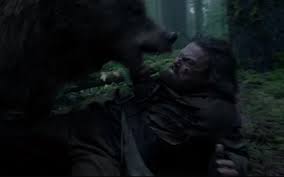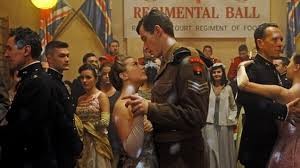EXUENT PURSUED BY A BEAR: Movie Reviews of The Revenant and Anomalisa by Howard Casner
Posted: January 14, 2016 | Author: Donald | Filed under: Uncategorized | Tags: Alejandro Gonzales Inarritu, Anomalisa, Charlie Kaufman, David Thewlis, Domhnall Gleeson, Duke Johnson, Emmanuel Lubezki, Jennifer Jason Leigh, Leonardo DiCaprio, Lukas Haas, Mark L. Smith, Michael Punka, The Revenant, Tom Hardy, Tom Noonan | 8,206 Comments »First, a word from our sponsors: I am now offering a new service: so much emphasis has been given lately to the importance of the opening of your screenplay, I now offer coverage for the first twenty pages at the cost of $20.00. For those who don’t want to have full coverage on their screenplay at this time, but want to know how well their script is working with the opening pages, this is perfect for you. I’ll help you not lose the reader on page one.
Ever wonder what a reader for a contest or agency thinks when he reads your screenplay? Check out my new e-book published on Amazon: Rantings and Ravings of a Screenplay Reader, including my series of essays, What I Learned Reading for Contests This Year, and my film reviews of 2013. Only $2.99. http://ow.ly/xN31r
and check out my Script Consultation Services: http://ow.ly/HPxKE
Warning: SPOILERS
 The Revenant is, perhaps, one of the most visceral movies you will see in some time. Everybody involved, from the technicians to the designers to the screenwriters (Mark L. Smith and Alejandro Gonzales Inarritu from a novel by Michael Punka), to the director (Inarritu) seemed to have gone out of their way to give the movie a feeling of verisimilitude that can be matched by few films.
The Revenant is, perhaps, one of the most visceral movies you will see in some time. Everybody involved, from the technicians to the designers to the screenwriters (Mark L. Smith and Alejandro Gonzales Inarritu from a novel by Michael Punka), to the director (Inarritu) seemed to have gone out of their way to give the movie a feeling of verisimilitude that can be matched by few films.
The dirty bodies and clothes and rotting teeth (you can almost smell the bad breath); the zip of an arrow through a man’s throat; the blood flowing from wounds made by knifes, bullets and hatchets; and the never ending harsh environment of snow and icy rivers (I almost caught the flu) are all paraded proudly for public consumption.
This is probably best demonstrated with what may now be the infamous bear attack scene in which our hero (Hugh Glass, played very bravely and stoically by Leonardo DiCaprio) is mauled, bitten and strewn all over the place by a mama grizzly fearing for her cubs. It’s an amazing bit of filmmaking and in many ways deserves all the praise it has earned.
And it goes on for a very long time. Read the rest of this entry »
MIXED DOUBLES: Movie Reviews of Legend and Night Owls by Howard Casner
Posted: December 17, 2015 | Author: Donald | Filed under: Uncategorized | Tags: Adam Pally, Brian Helgeland, Charles Hood, Chaz Palminteri, Christopher Eccleston, David Thewlis, Emily Browning, John Pearson, Legend, Night Owls, Peter Krause, Rob Huebel, Rosa Salazar, Seth Goldsmith, The Krays, Tom Hardy, Tony Hale | 2,422 Comments »First, a word from our sponsors: I am now offering a new service: so much emphasis has been given lately to the importance of the opening of your screenplay, I now offer coverage for the first twenty pages at the cost of $20.00. For those who don’t want to have full coverage on their screenplay at this time, but want to know how well their script is working with the opening pages, this is perfect for you. I’ll help you not lose the reader on page one.
Ever wonder what a reader for a contest or agency thinks when he reads your screenplay? Check out my new e-book published on Amazon: Rantings and Ravings of a Screenplay Reader, including my series of essays, What I Learned Reading for Contests This Year, and my film reviews of 2013. Only $2.99. http://ow.ly/xN31r
and check out my Script Consultation Services: http://ow.ly/HPxKE
Warning: SPOILERS
 Night Owls, the new self- contained, nearly two person drama written by Seth Goldsmith and the director Charles Hood, takes place in a single location: an upper middle class home.
Night Owls, the new self- contained, nearly two person drama written by Seth Goldsmith and the director Charles Hood, takes place in a single location: an upper middle class home.
Poor schlep Kevin gets lucky one night and is picked up at a party by Madeline, a sexy young thing. He takes her to what he thinks is her home and they make the beasts with two backs.
Afterward Kevin wakes up alone in bed. As he gets ready to leave, he discovers that he’s in his boss’s house and that Madeline is his boss’s mistress. Even worse, Madeline has tried to kill herself by taking a bottle of pills (don’t you just hate when that happens), so Kevin has to call a co-worker who then calls a doctor (well, a podiatrist, but the principle is the same).
After helping Madeline regain consciousness, the doctor tells Kevin he has to keep her awake for the rest of the night or she might die. So the two spend one of those evenings together where souls are bared, life lessons are learned and characters arc. Read the rest of this entry »
THE GOOD, THE NOT SO BAD AND THE UGLY: AFI 2015, Part 4: Married Without Children – 45 Years and Macbeth
Posted: December 8, 2015 | Author: Donald | Filed under: Uncategorized | Tags: 45 Years, Andrew Haigh, Charlotte Rampling, David Constantine, David Thewlis, Justin Kurzel, Macbeth, Marion Cotillard, Michael Fassbender, Paddy Considine, Snowtown, Tom Courtenay, William Shakespeare | 31 Comments »First, a word from our sponsors: I am now offering a new service: so much emphasis has been given lately to the importance of the opening of your screenplay, I now offer coverage for the first twenty pages at the cost of $20.00. For those who don’t want to have full coverage on their screenplay at this time, but want to know how well their script is working with the opening pages, this is perfect for you. I’ll help you not lose the reader on page one.
Ever wonder what a reader for a contest or agency thinks when he reads your screenplay? Check out my new e-book published on Amazon: Rantings and Ravings of a Screenplay Reader, including my series of essays, What I Learned Reading for Contests This Year, and my film reviews of 2013. Only $2.99. http://ow.ly/xN31r
and check out my Script Consultation Services: http://ow.ly/HPxKE
Warning: SPOILERS
 Is this the year of the older, older woman?
Is this the year of the older, older woman?
For some reason, a number of films have been released this year with a central character that is probably not only not in any recognized quadrant of the four that studios so dream of capturing, it’s a target audience many producers probably consider non-existent: a female in her somewhat twilight years.
These include I’ll See You In My Dreams (Blythe Danner as a widow discovering that life isn’t over by any stretch of the imagination); Grandma (Lily Tomlin as a grandmother helping her granddaughter raise money for an abortion); Youth (Jane Fonda as an aging actress desperately trying to hold on to her career); The Woman in the Van (curmudgeon Maggie Smith as…a curmudgeon in a van).
And now we have Charlotte Rampling as Kate Mercer in 45 Years, a heartbreaking and at times emotionally devastating film about a wife who has to reevaluate her more than four decade long marriage in the days leading up to her and her husband’s anniversary.
It’s a roster that perhaps is worthy of an entry in the Guinness Books. Read the rest of this entry »
THERE’LL ALWAYS BE AN ENGLAND SEQUEL: Movie reviews of Queen and Country and The Second Best Exotic Marigold Hotel by Howard Casner
Posted: March 11, 2015 | Author: Donald | Filed under: Uncategorized | Tags: Bill Nighy, Caleb Landry Jones, Callum Turner, Celia Imrie, David Strathairn, David Thewlis, Dev Patel, Diana Hardcastle, John Boorman, John Madden, Judy Dench, Lillette Dubey, Maggie Smith, Ol Parker, Pat Shortt, Penelope Wilton, Queen and Country, Richard E. Grant, Richard Gere, Ronald Pickup, Tamsin Greg, The Second Best Exotic Marigold Hotel | 688 Comments »First, a word from our sponsors. Ever wonder what a reader for a contest or agency thinks when he reads your screenplay? Check out my new e-book published on Amazon: Rantings and Ravings of a Screenplay Reader, including my series of essays, What I Learned Reading for Contests This Year, and my film reviews of 2013. Only $2.99. http://ow.ly/xN31r
and check out my Script Consultation Services: http://ow.ly/HPxKE
Warning: SPOILERS
 Queen and Country, the new semi-autobiographical film from writer/director John Boorman (the semi part) is a sequel to Boorman’s earlier film Hope and Glory, an episodic comedy about a young lad’s picturesque adventures during World War II.
Queen and Country, the new semi-autobiographical film from writer/director John Boorman (the semi part) is a sequel to Boorman’s earlier film Hope and Glory, an episodic comedy about a young lad’s picturesque adventures during World War II.
When we last saw the wee Bill, he had arrived at school to see it on fire from having been bombed during the Blitzkrieg, prompting him to yell out, “Thank you, Adolf”. It’s nearly a decade later now and Bill is an older teen and is conscripted into the army during the Korean War.
How you respond to Queen and Country will probably depend on how you respond to the way Bill is dramatized here. Personally, and to be ruthlessly honest, I found him a poor excuse for a human being who, first, has an amazing inability to fully comprehend just how lucky he is, and second, for someone whose future lies as a filmmaker, an amazing inability to understand, empathize or read the people he interacts with. Read the rest of this entry »
REEL MEN, REAL MEN, PART TWO: Movie review of Mr. Turner, Saint Laurent and The Theory of Everything by Howard Casner
Posted: November 25, 2014 | Author: Donald | Filed under: Uncategorized | Tags: Anthony McCarten, Bertrand Bonello, Brady Corbet, Charlie Cox, Christian McKay Emily Watson, David Thewlis, Dennis Sciama, Dick Pope, Dorothy Atkinson, Eddie Redmayne, Felicity Jones, Gaspard Ulliel, Helmut Berger, Jacqueline Durran, James Marsh, Jérémie Renier, Lea Seydoux, Louis Garrel, Marion Bailey, Martin Savage, Mike Leigh, Mr. Turner, Ruth Sheen, Saint Laurent, Simon McBurney, Stephen Hawking, Suzie Davies, The Theory of Everything, Thomas Bidegan, Timothy Spall | 26 Comments »First, a word from our sponsors. Ever wonder what a reader for a contest or agency thinks when he reads your screenplay? Check out my new e-book published on Amazon: Rantings and Ravings of a Screenplay Reader, including my series of essays, What I Learned Reading for Contests This Year, and my film reviews of 2013. Only $2.99. http://ow.ly/xN31r
Warning: SPOILERS
 I continue now with my reviews of the sudden spate of movies based on real people that are arriving late in the year because, well, we’re entering awards season, and what awards season would be complete without an overabundance of inspired by true event stories.
I continue now with my reviews of the sudden spate of movies based on real people that are arriving late in the year because, well, we’re entering awards season, and what awards season would be complete without an overabundance of inspired by true event stories.
First up…
Early on in Mr. Turner, writer/director Mike Leigh’s latest film about the famed 19th century land- and seascape artist, his servants prepare a pig’s head for a meal.
What is so interesting about this, and the reason I draw attention to it, is that the porcine’s pate bears a remarkable resemblance to the great painter himself with the artist constantly snorting and grunting as if Babe was his mother (or father, I can’t remember whether that famed shoat was a boar or a sow).
In fact, one might say that, Timothy Spall, a member of Leigh’s stock company of actors and who plays the title character here, does one of the greatest, if not greatest, imitation of a sus scrofa domesticus I’ve ever encountered in cinematic history. If someone is planning a remake of Animal Farm, I think we have our Old Napoleon.
It may be a dubious distinction, but a distinction none the less. Read the rest of this entry »
Movie Reviews of ENOUGH SAID and THE FIFTH ESTATE by Howard Casner
Posted: November 4, 2013 | Author: Donald | Filed under: Uncategorized | Tags: Ben Falcone, Benedict Cumberbatch, Bill Condon, Catherine Keener, Dan Stevens, Daniel Bruhl, David Thewlis, Enough Said, James Gandolfini, Josh Singer, Julia Louis-Dreyfuss, Moritz Bleibtrau. Laura Linney, Nicole Holocener, Peter Capaldi, Stanley Tucci, The Fifth Estate, Toni Collette, Wikileaks | 854 Comments »There is a sculpture in Chicago in front of City Hall. It’s by Picasso. It’s okay. I thought it was rather derivative and that there wasn’t anything that special about it. To be honest, what I thought when I first saw it was that Chicago paid a fortune to get the great artist to create a sculpture just for the city and all we got was…a Picasso. And I thought we deserved more.
I have now seen every one of writer/director Nicole Holocener’s movies, and I’ll definitely keep on seeking future ones out. I’ve enjoyed them well enough, and her dialog and characterizations are strong, insightful and full of empathy, something most movies seem to lack these days (though I do wish she would do something about her flat and routine visual style).
At the same time, though, I am finding myself, well, wanting more than enjoying them well enough. I find myself so wanting her to take a leap forward, so wanting her to make her Annie Hall, her Dogma, her Raising Arizona or Fargo, her Pulp Fiction, her Lost in Translation. Instead, what we’re getting here, in her new film, Enough Said, is…a Picasso. And it’s a good film, but it’s also just…a Picasso.
The basic story revolves around Eva (a perky Julia Louis-Dreyfuss), a divorced mother who makes a living as a masseuse, who meets two people at a party: the refined, somewhat snobby poet Marianne (Catherine Keener, and what movie by Holocener would be complete without Keener in it) and the less refined, teddy bear Albert (James Gandolfini in his next to last film performance, which gives the whole thing an unintended, but somewhat, whimsical sadness to it). Marianne hires Eva to massage her and the two become good friends. Albert asks Eva out and they become lovers. What Eva quickly finds out, but the others don’t know, is that Eva and Albert are bitter, bitter, bitter exes who keep telling Eva how awful a mate the other one was.
In other words, the basic set up is a farce and it’s a great idea. Unfortunately, the pacing is anything but. And after while, I found myself antsy because all I was waiting for was the big reveal. And it took what seemed a longer than necessary period of time to get there.
I’m also not sure I fully bought the relationships either. And I don’t mean the present tense ones. The more Marianne and Albert talk about each other behind each others’ backs, Eva never seems to ask the most logical question of the story: why did they ever get married in the first place? They seem to be the last two people who would ever go out on a first date, must less tie the knot.
Eva and Albert’s relationship is a bit more convincing because both Louis-Dreyfuss and Gandolfini work very hard at it and there is a sweet chemistry to the two of them. At the same time, I sometimes got the feeling they started a relationship simply because there wasn’t anyone else around. In the end, the most convincing couple in the room are Sarah and Will (Toni Collette and Ben Falcone), Eva’s best friends and comic relief. They seem so right for each other and Collette and Falcone give razor sharp performances, they’re the kind of couple who get each other even when they get on each other’s nerves.
In the end, maybe Holocener isn’t that interested in making that leap forward. That may not be the direction she wants to go in. And I guess there’s nothing wrong with that. Maybe that’s okay. And maybe it’s just a prejudice of mine that artist’s should take leaps forward. But god, I so wish she would. We have enough Picassos.
The Fifth Estate, written by Josh Singer and directed by Bill Condon, is a hi-tech espionage thriller disguised as a bromance, or a bromance disguised as a hi-tech espionage thriller. I’m not sure which. I’m not sure I want to know.
For those of you just returned from the Antarctic, The Fifth Estate is about the Private Lives relationship (you know what I mean, can’t live with, can’t live without type thing) between Julian Assange and Daniel Berg, the creators of the king of all hacker sites Wikileaks. And what a relationship it is, too. Like any good Fred Astaire/Ginger Rogers movie, they meet cute; flirt; get jealous of each others’ lovers; try to sabotage each others’ relationships; cheat on each other; have make-up sex (in the form of releasing a shocking video of the American military shooting and killing unarmed civilians and journalists—it was good for me, was it good for you, too?). The love affair metaphor here is so heavy handed that it is embarrassing and even cringe worthy at times (you almost want to yell at the screen, “get a room, already, why don’t you”). At one moment I expected Assange to say “You complete me” to Berg and Berg to say to Assange, “I wish I could quit you”. The only place it really deviates from formula is that unlike most rom coms, The Fifth Estate has an unhappy ending as Berg, like any good starter wife, gets traded in for a younger model.
If this movie had been made in the 1950’s, I would have expected it to star Joan Crawford or Barbara Stanwyck and Zachary Scott or Fred MacMurray. Instead we have Benedict Cumberbatch as Assange (with shocking white hair as if he were an elf extra in the Lord of the Rings) and Daniel Bruhl as Berg. There’s absolutely no chemistry between the two and their characters just never come to life (though I have to say in Cumberbatch’s defense, he is stuck with imitating someone with one of the dullest speaking voices in some time).
And poor Berg. After giving some solid and satisfying performances in such films as Good Bye Lenin!, The Edukators and Inglorious Basterds, he just can’t seem to find a role that suits him. And it doesn’t help that here he can’t get any more heat going with his co-star than he could with Chris Hemsworth in Rush, another Beatrice/Benedict relationship that also couldn’t get off the ground (or out of the starting gate).
It’s all so unfortunate. Because when the film focuses on the actual Wikileaks story, it’s rather exciting. Condon’s direction just refuses to let the action lag and the whole thing is filled with a bunch of fun visuals to keep the tension, well…extremely tense. But whenever the thriller returns to the love story, the whole thing sinks like the Titanic, taking its two stars with them.
I must say, though, it does have an interesting supporting cast. Some surprising people keep popping up, like the future Dr. Who, Peter Capaldi; Mike Leigh refugee, David Thewlis; Downton Abby ex, Dan Stevens; and the wonderful Moritz Bleibtrau, one of Germany’s best actors (Run, Lola, Run; Munich; and the Baader Meinhoff Complex).
It also has Laura Linney and Stanley Tucci as U.S. state department officers who, for some reason, always feel a tad out of sync with the rest of the movie. Part of this may be because they are too familiar of actors for their roles. But part of it may be because they give the most vibrant line readings and their platonic romance is infinitely more believable than Cumberbatch’s and Bruhl’s.
Movie Reviews of IN THE FOG, RED 2 and THE CONJURING by Howard Casner
Posted: July 27, 2013 | Author: Donald | Filed under: Uncategorized | Tags: Anthony Hopkins, Brian Cox, Bruce Willis, Byung-hun Lee, Carey Hayes, Catherine Zeta-Jones, Chad Hayes, David Thewlis, Dean Parisot, Erich Hoeber, Helen Mirren, In the Fog, John Malkovich, Jon Hoeber, Lily Taylor, Mary-Louise Parker, Neal McDonough, Patrick Wilson, Ron Livingston, Sergei Loznitsa, Sergie Kolesov Red 2, The Conjuring, Vera Farmiga James Wan, Vladimir Svirskiy, Vladislav Abashin | 22 Comments »In a Russian village recently taken over by the Germans during World War II, six men are marched out to be hung for being part of the underground. One is pardoned. Assuming that the pardoned one must have been an informer, two Russian soldiers are sent to kill him. The one pardoned denies having done anything wrong, but can’t explain why he was released. It doesn’t matter. It’s gotten to the point where he’s not sure whether he wants to live or die as it is.
In the Fog is a story about a group of people trapped in a nightmarish situation that cannot have a satisfactory ending for anyone involved. Reminiscent in certain ways of Army of Shadows (Jean Pierre-Melville’s powerful story of French resistance fighters), all the characters are forced to make up their own morality as they go along because there are no standards to cover their situation. As a result the three men find themselves in both a literal and metaphorical miasma that is referenced by the title. It’s a harsh, unflinching and deeply moving story about a situation that most of us will never find ourselves in.
Written and directed by Sergei Loznitsa, with Vladislav Abashin, Vladimir Svirskiy and Sergie Kolesov as the three men.
I would truly love someone to explain this to me: Pacific Rim, which is filled with one-dimensional characters, bland actors, even blander acting, and even blander dialog, with a slip-shod script, a movie that has almost nothing to redeem it except some neat CGI (as if the producer/director/writer thought that’s all a movie is, instead of that being the least a movie should be), gets a 65% with top critics on rottentomatoes.com (72% all critics), while Red 2, a thrill ride of a movie with brilliant actors playing fun and vibrant characters, spouting witty dialog worthy of, well I won’t go Oscar Wilde, but I will go Noel Coward, in a clever plot and a story not dependent on special effects, only gets a 28% from top critics and a 39% from all critics? Maybe contemporary wisdom is wrong. Maybe it’s not the studios that are the problem here if critics can’t even tell the difference between a good blockbuster and a bad one.
Red 2 is a sequel to Red (okay, not much originality there, but still). As in the earlier one, a bunch of over the hill secret agents get caught up in some totally ridiculous set of circumstances whose purpose is not so much to make sense, but to give the audience a great time watching over the hill actors get to do things over the hill actors are almost never allowed to do (unless you’re Sean Connery). I won’t try to explain the plot except to say it’s as dexterous as a roller coaster at Six Flags and involves some sort of apocalyptic macguffin mumbo jumbo and a bomb planted in the Kremlin.
Many of the usual suspects are here. Bruce Willis and Mary-Louise Parker are still working out their Nick and Nora Charles relationship while John Malkovich plays the part of the guy who is summed up with the old chestnut, “just because you’re paranoid doesn’t mean they’re not out to get you” (and having the time of his life doing so). Also back on board is Helen Mirren, channeling Julie Newmar by purring her way through her part as a hired assassin, whether she’s dumping acid on a dead body or shooting Russian soldiers while lying on a picnic blanket with her stocking foot curled up as if she’s having an orgasm. They are joined by newcomers of various generations, including Anthony Hopkins as a mad doctor; Catherine Zeta-Jones as Kryptonite (she plays a woman in lust with Bruce Willis and all involved carry this off without one reference to Michael Douglas, which may actually be the real miracle here); Byung-hun Lee (the great star of Korean films like I Saw the Devil and The Good, The Bad and The Weird) as a Bruce Lee type martial arts expert who owns his own plane; David Thewlis who traffics in stolen information, but has an Achille’s punt (that pun’s a bit obscure, but I’ll go with it anyway); Brian Cox as a Russian agent who has a foot fetish (but it’s Mirren’s foot, so who can blame him); and Neal McDonough as a fascist with the smile of a Neo-Nazi.
Directed by Dean (Galaxy Quest, which may explain a lot) Parisot and written by Jon and Erich Hoeber (who wrote Battleship, which doesn’t, though the source material, a graphic novel by Warren Ellis and Cully Hamner, may).
The Conjuring is one of those horror movies like The Innocents and The Haunting about creepy crawly doings at a house in a remote location. A family made up of mother, father and five, count ‘em, five, girls move into a fixer-upper whereupon slowly, but surely, ominous things start happening, the sort of things that get so bad, the family feels compelled to call in demonologist experts Ed and Lorraine Warren (most famous for their investigation of the Amytiville Horror—oh, did I forget to mention that The Conjuring is based on a true story—well, that’s their story and their sticking to it).
The movie starts out rather well with some nice fun and wittily eerie scenes (one involving a hide and seek game that employs clapping). The house itself is a marvel of design and becomes a character in its own right (with gigantic basements and crawlspaces). And the family is headed by Lily Taylor and Ron Livingston, who give first rate performances (why, oh, why isn’t Lily Taylor given more to do in films).
Things get a bit harder to take seriously when Patrick Wilson and Vera Farmiga as the demonologists enter the scene. They have a totally different acting style than the others (they underplay to a fault, apparently to emphasize how every day the supernatural is to Ed and Lorraine—they have lines like demons can stick to you like gum on a shoe). They’re a bit stiff to the point that a few generations before this, they’d make perfect models for American Gothic. What also doesn’t help is that the movie takes place in the 1970’s and just one look at Wilson in his sideburns and polyester suit and Farmiga in her granny dress, and it’s hard not to let out an unintentional giggle or two (it was the ‘70’s; what did we know about fashion).
The movie has a nice build in the beginning (it doesn’t rush things as too many scare fests do); has its fair amount of frights; and there’s enough mood left over to feed an orphanage. But by the end of the movie, director James Wan and writers Chad and Carey Hayes go for broke and basically throw everything at the story except the kitchen sink (which kind of makes sense since, in the movie, the various demons throw everything at the characters except the kitchen sink). At this point, the movie becomes a fairly routine and pedestrian ghost story.
Perhaps what is most disturbing, though, is the idea that the witches killed at Salem (you remember them from history class, right) weren’t just poor beggar women or people who made enemies of the wrong people or an injustice grown out of sexual hysteria—no, according to the movie, the Salem witches were really, well, witches. Huh. Who’d a thought it?











